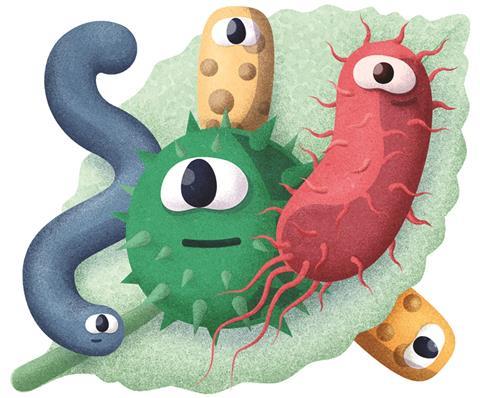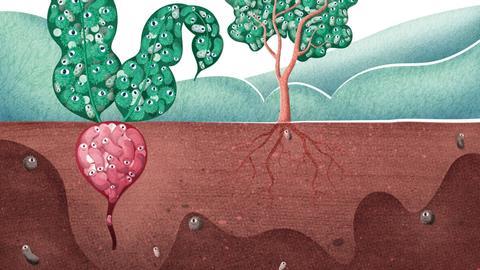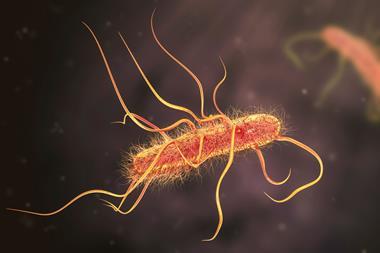The key to healthy plants is healthy microbiomes. Anthony King meets the crop scientists hoping to boost yields by managing microorganisms
In 1988, a remarkable finding illuminated a new path that agricultural scientists would soon follow in their quest to maximise crop yields. The first step was the discovery of a microbe that fixes nitrogen in the sap of sugarcane growing in Brazil. The microbe converts inert nitrogen in air to useful ammonia, explaining why sugar cane needs little nitrogen fertiliser to thrive. This was entirely unexpected; nitrogen-fixing bacteria had until then only been found in special root structures known as nodules.
It’s long been known that legumes such as peas, clover, soy and beans host nodules on their roots and gain benefits from the bacteria inside them. School textbooks recount this as classic symbiotic relationship; bugs converting nitrogen in the air into ammonia for the plant and receiving sugars in return. Today, soybeans planted across millions of hectares are inoculated with such bacteria as a coating on their seeds to boost yields.
For years plant scientists had tried without success to move these nitrogen-fixing nodules into cereal crops so they too could fix nitrogen from air and cut down on fertiliser use. Following the sugarcane discovery, researchers realised that if they could use this unusual microbe to fix nitrogen inside major food crops it would be a boon for agricultural industry.

Edward Cocking at the University of Nottingham, UK, set himself to this task. He isolated the microbe in sugarcane sap, Gluconacetobacter diazotrophicus, and dropped it into various food crops. ‘I investigated the bacteria in the major cereals of the world as well as other important crop plants such as tomatoes,’ says Cocking. ‘It colonised all of those.’ His start-up, Azotic Technologies, is now in its seventh year of field trials, which have taken place in the US, Europe and Asia. They have shown a reduced need for nitrogen fertiliser and increased of yields in wheat, maize and rice. The field trials are set to continue in 2018.
Plants have immune systems and only some strains are allowed in
Jeff Dangl, University of North Carolina at Chapel Hill
It used to be thought that plants and trees were a microbial desert, but we know now that the presence of Gluconacetobacter diazotrophicus inside sugarcane is not an entirely unusual situation. And the sheer quantity of bacteria that have been found inside plants is remarkable. ‘One gram of fruit can hold 108 bacteria,’ says Davide Bulgarelli, plant microbiologist at the University of Dundee, UK.
Over the past decade the wider availability of DNA sequencing technology has brought to light the huge variety of bacteria within a single plant. We now know that a microbial zoo – the equivalent of the human microbiome – exists inside many different plant and tree species. And, intriguingly, the same types of microbes keep showing up. ‘There is a core microbiome that is winnowed from what is a highly complex community within soils,’ explains Jeff Dangl at the University of North Carolina at Chapel Hill, US, a leader in this field. The surprise is not how diverse the soil community is but the steep decline in diversity closer to the roots, then on the roots and finally inside the plant, where perhaps only 200 species gain a pass. ‘Plants have immune systems and only some strains are allowed in,’ says Dangl.
And it isn’t just microbes that assist with nitrogen fixation that are being allowed in. ‘Plants actively recruit microbes that can provide them with ecosystem services, from nutrient sequestration to suppressing pathogen growth,’ explains Dangl. ‘Plants colonised with endophytes [microbes living inside them] are typically more resistant to abiotic stresses like cold and biotic stresses like other pathogenic microorganisms,’ says Frank Takken, plant scientist at the University of Amsterdam, the Netherlands. The bacteria on the outside of plants, especially near the roots, have also proven important.
A number of ‘good’ bacteria have now been linked to heightened resilience and yield in the face of drought, heat stress, salinity and plant disease. Inoculating crops with these could not only improve yields but also fight off disease without the need for chemicals or genetic modification.
Many times bacteria strains have succeeded in the lab and greenhouse, before flopping in a field trial
Lab to field hurdles
The next step after identifying these useful bacteria was to figure out how to grow them in equally useful numbers. ‘About 50% of the bacteria in the microbiome can now be cultured,’ says Bulgarelli. This has allowed testing of various bacteria in and on different plants and crops. But there have been mixed results: many times bacteria strains have succeeded in the lab and greenhouse, before flopping in a field trial. ‘Time and again when we inoculate with individual strains of bacteria, they do not establish themselves,’ explains microbiologist Tim Mauchline from Rothamsted Research in Hertfordshire, UK. ‘They are outcompeted by the established soil microflora.’
Dangl gives the example of the successful inoculation of soybeans by nitrogen-fixing rhizobia bacteria; soybeans as legumes naturally grow root nodules, but inoculations give them a head start. ‘You coat seeds in a super-nodulating strain that was isolated in the lab. The plant starts to nodulate earlier, with your favourite strain,’ Dangl explains, which benefits the crop. ‘But it turns out that as the root develops, the nodules become filled by endogenous rhizobia from the field.’ The preferred strain succumbs to natural soil inhabitants. ‘We have to fight this problem of how to make sure a strain can invade and persist in a complicated soil community.’
Takken’s group has also experienced this frustration. Tomatoes were successfully inoculated with endophytic fungal strains in his lab, achieving ‘good protection against subsequent attack by pathogenic strains’, but the field results were inconsistent. He is continuing to hunt for protective strains and is also exploring the underlying molecular mechanisms of endophyte-mediated disease control. ‘We are screening different fungal strains for their ability to confer protection to pathogenic strains. This screen aims to identify the best strains to use in the field,’ he explains. He is part of a European project (BestPass) that is screening dozens of varieties of tomatoes and their relatives to ‘see if there are genetic factors that we can breed to make our crop plants better adapted for certain symbionts’. By tailoring the plants, perhaps the outcome of microbial battles could be tilted towards specific bacterial species. Other groups are also exploring whether certain crop varieties are better suited to harnessing useful microbes in the soil.
Exploring ancestral microbiomes
The quest to discover whether certain crop varieties are better suited than others to harnessing useful microbes in the soil has thrown up an interesting possibility: that plants may have lost the ability to send chemical signals to recruit certain microbes during domestication. When they started to be fed fertiliser and regularly watered, maintaining this capability became less necessary. The resurrection of crops with wild microbiomes is therefore being explored.
‘Most breeding has not taken anything microbial into account,’ explains Susannah Tringe, microbiologist at the Joint Genome Institute in Walnut Creek, US. Plant breeding may have accidentally dropped some of the signals needed to attract the wild ‘ancestral’ microbiome, but now we are aware of these signals, we could potentially breed the necessary genes back into crops. She is interested in developing more stress tolerant sorghum, an energy crop in the US, by breeding varieties that can better recruit bugs that boost resilience.
‘Modern crops may have lost their ability to communicate with soil microbiome,’ agrees microbiologist Tim Mauchline from Rothamsted Research in Hertfordshire, UK. His team is looking at the root chemistry of wheat cultivars to see which organics are secreted by their roots and which of these are potentially significant in recruiting helpful bacteria. The differences between wheat varieties and whether older cultivars may have retained superior signalling capabilities are also being explored. ‘If we take a journey back in time, looking at ancestral varieties, we could reinstate these interactions in modern varieties,’ says Mauchline.
In a similar vein, Davide Bulgarelli, plant microbiologist at the University of Dundee, UK, found subtle differences between the microbiome of wild and domesticated barley.4 He is, however, open minded about which of these microbiomes is better for plant growth. The wild barley could be superior in recruiting microbial helpers, especially in tougher conditions, he says, or on the other hand the microbiome in modern crop varieties might be better tailored to agriculture.
Better together
Cocktails of useful bacteria is another approach being explored, with so-called ‘synthetic communities’ now being tested in various combinations. ‘When you apply one inoculant to the soil it faces competition from other microorganisms that could kill them or create suboptimal conditions,’ says Bulgarelli. Combinations can assist each other or provide redundancy, so growers are not betting all their chips on one strain.
Recent research by Roberto Kolter at Harvard Medical School, Boston, US, for example, looked at a seven-species bacterial community in maize roots, removing one species at a time. The seven-strong consortium proved better at fighting off late blight disease than any one member alone.1
There has also been a piling up of evidence that beneficial microbes can be gainfully swapped between plant types. This means a beneficial microbe found on one sort of plant can be transferred to an unrelated species, with the same benefits seen. A recent meta-analysis confirmed that relocated endophytes were successfully mitigating drought, nitrogen deficiency and salinity stress, with little evidence of plant-microbe specificity.2
Some people thought the symbiosis might cost the plant because it has to give up some sugars to the microbe. But we didn’t see that effect.
Sharon Doty, University of Washington, Seatlle, US
Sharon Doty, plant microbiologist at the University of Washington in Seattle, US, for example, recently isolated around 10 bacteria and yeast from inside poplar and willow trees and placed them on corn, tomato, pepper, squash, sunflower and grasses.3 Inoculated crop plants showed better viability and flowered and fruited earlier.
Symbiosis is often seen as a trade-off, whereby a plant pays microbes in sugars in return for some other gain, such as protection from disease. The carbon giveaway of wild plants is worth it for what they get in return from microbial partners but in agriculture yield is paramount and some questioned if the trade would work here. ‘Some people thought the symbiosis might cost the plant because it has to give up some sugars to the microbe. But we didn’t see that effect. For some cherry tomatoes we had twice the fruit yield in limited fertiliser,’ Doty recalls.
Companies step in
Doty’s lab has licensed out her mixture of 10 bacteria strains to engineering company Intrinsyx Technologies. It has performed greenhouse trials and is now carrying out field trials in California on rice, maize, strawberries, kale and broccoli, as well as citrus and almond trees. It is looking at whether or not the bacteria mixture increases growth and drought tolerance in the plants. ‘They are really happy with the results they’ve seen so far,’ she says.
Dangl, meanwhile, helped found start-up AgBiome in 2012. AgBiome has isolated thousands of microbes using DNA sequencing and computational genomics and ran greenhouse and field trials with promising candidates. In 2017 it launched its first two products: biological fungicides designed to protect plants against a broad range of fungal diseases. Howler has been developed for use on specialty crops, while Zio is aimed at the turf and ornamental industry. The microbes in these products become part of the plants’ microbiomes and combat fungal diseases through multiple mechanisms. ‘The microbes being developed by us and other companies are as effective as the current chemical controls for certain disease,’ enthuses Dangl. ‘We are not talking about a microbe that will be used together with a [traditional] fungicide. Our goal is to replace fungicides.’
Around 2% of the world’s energy consumption currently goes towards the industrial manufacture of nitrogen.
These are just two of the companies now operating in this space: both start-ups and large international seed companies are increasingly interested in seed coatings or soil treatments that put helpful bacteria both inside, and on the surface of, the big food crops such as rice, corn and wheat (see box above for some more examples). ‘It took a while for people to accept that these microbes are something that should be looked at,’ says Doty. ‘I think in the next year or two this is really going to explode [with new products].’
Around 2% of the world’s energy consumption currently goes towards the industrial manufacture of nitrogen. Microbial products are expected to lessen the need for costly fertilisers, while also slashing the use of chemical pesticides and fungicides. ‘There are tonnes of profit to be made from sustainable agriculture,’ says Dangl. ‘Doing the right thing for the planet is going to drive business.’
Anthony King is a science writer based in Dublin, Ireland
Some other companies operating in the plant microbiome space
| Company | Headquartered | Example microbial product on market or in development |
|---|---|---|
|
Verdesian Life Sciences |
Cary, North Carolina, US |
A number of microbial seed treatments on the market, including Accolade for wheat that boosts root development to increase nutrient uptake and therefore yields |
|
Indigo Agriculture |
Boston, Massachusetts, US |
Sells seeds coated in microbes for corn, cotton, rice, soybeans and wheat. Its microbe-coated cotton seed reportedly offers an 11% yield boost in low-water conditions |
|
BioAg Alliance |
Collaboration between US-headquartered Monsanto and Novozymes in Denmark |
Collaboration formed in 2014 to utilise naturally occurring microbes to improve yields. First product launched in 2016, the corn inoculant Acceleron B-300 SAT derived from a fungus found in soil. In trials, this coating boosted yields by more than three bushels per acre (one bushel is equivalent to 35 litres) |
|
BioConsortia |
Davis, California, US |
A pipeline of microbial consortia products is in development for reducing fertiliser use and promoting growth and other beneficial crop traits such as tolerance to drought, salt and cold. Its focus is on corn, wheat, soybean, tomatoes, leafy vegetables and turf |
|
Agnition
|
Balaton, Minnesota |
In 2016, the company launched a microbial catalyst seed treatment for corn that stimulates natural microbial activity in the soil to provide a superior growth environment |
References
1 B Niu et al,Proc. Natl. Acad. Sci. USA, 2017, 114, E2450 (DOI: 10.1073/pnas.1616148114)
2 H Rho et al, Microb Ecol., 2017 (DOI: 10.1007/s00248-017-1054-3)
3 Z Khan et al,ISRN Agron., 2012, 890280 (DOI: 10.5402/2012/890280)
4 D Bulgarelli et al,Cell Host Microbe, 2015, 17, 392 (DOI: 10.1016/j.chom.2015.01.011)













1 Reader's comment